|

Uncovering the Riches of Peru's Pomac Forest: The Pre-Inca Treasures of the Sican Culture
Sican treasures gleam,
Amidst the lush Pomac woods,
Echoes of the past.
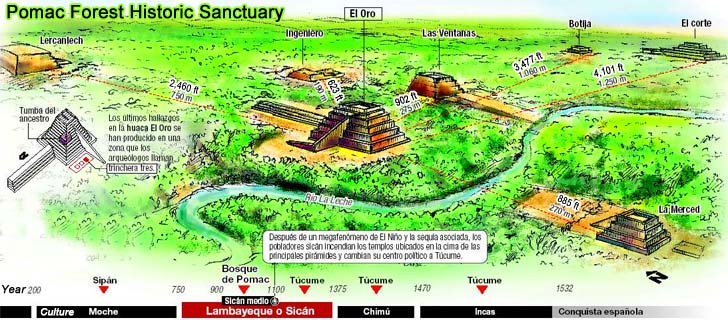
Above original infographic
by
El Comercio.
|
Pre-Inca burial site found
November 22, 2006.
Source:
The Daily Telegraph, Agence France-Presse.
A Spectacular burial site of 20 tombs for the pre-Inca
nobility of Sican has been found in northern Peru, the
archaeological expedition's Japanese leader Izumi
Shimada said today.
The discovery, one of the most significant finds in Peru
in recent years, should allow for greater understanding
of the Sican culture, which spanned from about 750 AD to
the end of the 14th century.
The entrails of the Pomac Forest Historic Sanctuary
finally revealed one of the old secrets kept by these
Peruvian ancestors who had special interest in
worshiping their dead.
For that purpose they constructed pyramids that even
today emerge between one the oldest and densest carob
trees forests in the world, located in the district of
Pítipo, in Ferreñafe, near the northern Peruvian city of
Chimbote.
|
|

Izumi Shimada is the world's top expert on the culture
of two ancient Peruvian peoples, the Moche and the Sicán.
His excavation of a Sicán religious and cermonial
center, begun 26 years ago, is the longest continuous
archaeological project in South America. |
Archaeologists found the
pyramid-shaped tombs containing a dozen ceremonial
knives, ceremonial figures called tumis, made in an
alloy of copper silver and gold, breastplates, masks and
ceramics, near the town of Ferrenafe, about 800
kilometres north of Lima.
|
|
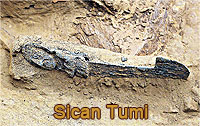
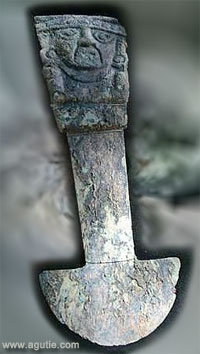
A tumi. A ceremonial knive measuring 35 cm (13.8 in.)
has an engraved image of the God Sicán or Naylamp.
|
Sican means "House of the Moon" in the muchik language.
Their culture developed sophisticated metalworking for the era
as well, researchers said, reaching its peak between AD
900-1100.
Along a 30-meter (100-foot) pyramid, archaeologists found in one
funeral chamber the bones of a young woman between 20 and 25
years of age surrounded by ceramics and objects of copper or
covered in gold as well as figurines of the Sican gods.
Several burial pyramids were found on the imposing site in
Lambayeque province.
The Sican culture was succeeded by the Chimus, then the Incas,
until the arrival of Spanish conquistadores in Peru in 1532.
The discovery's findings are to be exhibited in 2008 at The
National Science Museum in Tokyo.
The so-called "Lords of Sican" were considered
representatives of divine power on Earth.
|
|
|
Peruvian
archaeologists excavate first 'tumi' knives from
pre-Inca tombs
November 21, 2006.
Source: International Herald Tribune, Health/Science,
the Associated Press.
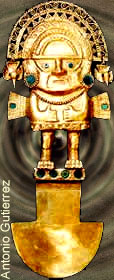 FERRENAFE,
Peru: Archaeologists said Tuesday they have unearthed 22
graves in northern Peru containing a trove of pre-Inca
artifacts, including the first "tumi" ceremonial knives
ever discovered by archaeologists rather than looted by
thieves.
FERRENAFE,
Peru: Archaeologists said Tuesday they have unearthed 22
graves in northern Peru containing a trove of pre-Inca
artifacts, including the first "tumi" ceremonial knives
ever discovered by archaeologists rather than looted by
thieves.
The find, which prominent archaeologist Walter Alva
called "overwhelmingly important," means that scientists
can study the tumi — Peru's national symbol — in a
natural setting to learn about the context in which it
was used.
"This discovery comes as an important contribution to
know the burial rites of the elite of this culture,"
said Alva, who was not involved in the dig. He confirmed
that no tumi had before been unearthed by
archaeologists.
The tombs, more than 900 years old, were found next to a
pyramid in the Pomac Forest Historical Sanctuary, 680
kilometers (420 miles) northwest of the capital, Lima.
They are from the Sican culture, which flourished on
Peru's northern desert coast from A.D. 750 to 1375.
The occupants "are clearly from the social elite and
therefore some of them have gold objects, some of them
have copper-gilded objects, but they are quite complex,
well-endowed tombs," said Izumi Shimada.
Shimada, an anthropology professor at Southern Illinois
University, began excavations at the site in July with
Carlos Elera Arevalo, director of Peru's Sican National
Museum. He said 10 tumi knives were found, including a
34-centimeter (14-inch) copper alloy tumi bearing the
image of the Sican deity.
"The tumi has for many years been the symbol of Peru,
and yet no decorated tumi has ever been found or
documented scientifically," he told The Associated
Press.
All known tumi knives were looted by grave robbers,
Shimada said. Sican artifacts, he has argued in his
research, were often misidentified as coming from the
later Inca Empire because they were always seen out of
context.
"It is the first time that such a tumi has been found in
context, in a scientific manner, and therefore we will
be able to speak a lot about the cultural significance
of this object," he said.
Alva — who led one of Peru's most famous archaeological
discoveries, the Lords of Sipan tombs, in the late 1980s
— agreed.
"Finally, archaeologists have the opportunity to show a
scientifically excavated tomb where the context can be
known for these objects," he said.
The archaeologist gave President Alan Garcia a tour
Tuesday of the excavation site, where Shimada said his
team has found 22 tombs at up to 10 meters (33 feet)
below ground level.
"This is an extraordinary find," Garcia said.
One grave contains the remains of a woman about 25 years
old buried with 120 miniature clay "crisoles," Shimada
said, which he believes were made by each member of the
funeral ceremony "as a sort of last offering to be
placed in the burial chamber."
|
|
|
Burial site sheds new
light on pre-Incan culture
November 22 2006. Source: Dragana
Kovacevic , DiscoveryChannel.ca
A discovery of twenty pyramid-shaped tombs in northern Peru could
help explain how the people of the even-more ancient Sican culture
lived and died.
Archeologists believe the find, which dates back about 1,000 years,
is one of the most significant in years.
The team, led by Peruvian and Japanese researchers, discovered the
tombs about 800 kilometers north of Lima, near the town of Ferrenafe.
Inside the burial chambers were breastplates, masks, ceramics and
ceremonial figures and knives, called tumis.
These tumis - made of an alloy containing copper, silver and gold -
were a particular find for scientists because this is the first time
they've been able to get them in their original environment and not
from tomb raiders.
The tombs that yielded these precious artifacts belonged to Sican
nobility - the "Lords of Sican".
|
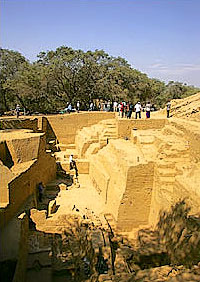
Buried in a pyramid 30m (100ft) long, archaeologists
found the bones of a woman in her early 20s surrounded
by figurines of Sican gods, ceramics and objects in
copper and gold.
Another set of bones, clearly from a person of some
stature, were found in a seated position accompanied by
a metallic crown, part of a thorny oyster, and various
ceramic objects including a vase.
|
Those people are considered representatives of divine power on
Earth. According to experts, these elites provided the spiritual
foundation for what the archeologists say was a religious, sacred
settlement.
The sites also show that the Sican were a highly organized society.
Among other things, they developed sophisticated metalworking
techniques.
The Sican occupied the region from about 750 AD to the late 1300s,
and were at their peak between 900 and 1100 AD - about one hundred
years before the Inca rose to prominence.
|
|
|
Facts about Pre-Inca civilization: Sican
-
The Sican Culture is the name
archaeologists have given to one of several gold-working peoples
who predated the Inca in what is now the north coast of Peru
between about 800-1300 AD.
-
They produced alloys of gold, silver
and arsenic-copper in unprecedented scales in pre-Hispanic
America. Known for their lost-wax gold ornaments and arsenical
copper (alloys of several copper mixtures and arsenic that can
be described as a brass type), which is the closest material to
bronze found in prehistoric New World archaeology and is
attributed to be the precursor of the brass age in the north of
Peru.
-
The Sican were probably descendants
of the Moche.
-
Around A.D. 800 they created the
city of Poma, located at Batan Grande, in the La Leche Valley.
Between A.D. 900-1100 it grew to become the region's political
and religious centre. The population of Batan Grande included
many skilled metal workers. The tombs of Batan Grande lords have
held gold and silver keros (beakers), emeralds, pearls and mummy
bundles with gold funerary masks with semi-precious stones,
shell and feathers.
Post a comment
|
|
|
|
|
|
|